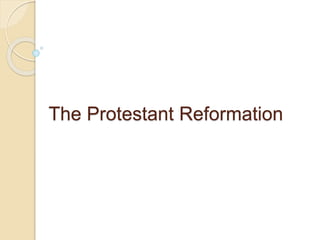
The Protestant Reformation
- 3. The Renaissance… Weakened the Church Printing press spread secular books However – the other problem was the Church itself ◦ Spent $ on personal pleasure ◦ Pursuing worldly affairs ◦ Priests broke vows by marrying and drinking/gambling ◦ Indulgences - _____________________
- 4. But…I guess I understand being a teacher I don’t make a TON of money…. So, I wanted to make a deal. Since we are almost to the end of the semester, I am going to make a bargain: ◦ If you want to give me $100 – I will give you an A. ◦ I will pardon you from all of your failing grades ◦ Any takers??
- 5. One man decided to make a change Martin Luther He wrote 95 Theses, or formal statements, attacking the “pardon-merchants” On October 31, 1517 – he posted these statements on the door of the castle church They were copied and became known all over Germany This became known as the Reformation – a movement for religious reform What exactly was this change about??
- 7. Document #2: Martin Luther posted 95 arguments against the pope on the door of Wittenberg Church, here are some of them. *“If the pope truly has the power to forgive sins, shouldn’t he do it for free out of love instead of for money?” *“All those who are sure of salvation because of indulgences will be doomed to Hell, together with their teachers.” *“Christians should be taught that one who gives to the poor, or lends to the needy, does a better action than if he purchases indulgences.” *“The pope’s indulgences cannot remove even the guilt of the smallest sins.” *“Since the pope is the richest man in the world, why doesn’t he use his own money to build churches instead of poor believers?” 1. How does Luther feel about indulgences? (Show video 4:43) 2. How does Luther feel about the pope? 3. Do you agree with Luther? Why or why not?
- 8. Document #3: Luther drew cartoons in his books to help the people understand his point. The first picture shows Jesus Christ carrying the cross on which he would be crucified. The second picture shows the pope in a very different situation. 1. Describe the 2nd picture in detail. 2. Explain the differences between the two pictures. 3. What point do you think Luther was trying to make?
- 9. Document #4: Luther drew cartoons in his books to help the people understand his point. The first picture shows the birth of Jesus Christ in a stable attended by animals. The second picture shows the pope in a very different situation. 1. Describe the 2nd picture in detail. 2. Explain the differences between the two pictures. 3. What point do you think Luther was trying to make?
- 10. Document #5: Music 1. Which church do you think this music came from? Why? Catholic Church Music • polyphonic style (many voices entering at different times) • clearly heard lyrics • step-by-step melodies and long phrases for a calm feeling • Latin lyrics Lutheran Church Music • Chordal style (multiple singers at once) • one syllable per note helps the words to be heard • regular beat • short musical phrases • German lyrics
- 11. Luther’s Teachings 1. People could win salvation only by ___________ in God’s gift of forgiveness. The Church taught that faith and “good works” were needed for salvation. 2. All Church teachings should be clearly based on the words of the Bible. Both the pope and church traditions were false authorities. 3. All people with faith were equal. Therefore, people did not need priests to
- 12. The Reaction to Luther How do you think the Church will react? *Pope Leo X excommunicated Luther for heresy *Holy Roman Emperor declared Luther an outlaw and that no one in his empire should give him food or shelter *Books should be burned How do you think his followers will react? *Luther translated the New Testament to German *Luther and his followers became a separate religious group called…?? -Lutherans! *Princes signed a protest against the pope and became known as Protestants *Protestants are Christians who belong to non-Catholic churches
- 13. Has anyone heard of predestination? John Calvin published Institutes of the Christian Religion. (Summary of Protestant theology) ◦ The religion based on his teachings is called Calvinism Predestination – God has known since the beginning of time who will be saved – “the elect” In his government - there were very strict rules ◦ No one wore bright clothing, no card games Did you know: *The Presbyterian Church was founded after a Scottish preacher named John Knox visited Geneva (Calvin’s model city) *Presbyters – were elders who governed the church
- 14. The Catholic Reformation Protestant churches won many followers, however, millions remained true to Catholicism However…in order to keep Catholics loyal to their church, what does the Catholic Church need to do? *insert – you say you want a revolution
- 15. The Counter Reformation Ignatius of Loyola – gathered followers and created the Society of Jesus ◦ “Jesuits” – focused on three activities: 1. Founded superb schools throughout Europe 2. Convert Non-Christians to Catholicism 3. Stop the spread of Protestantism Popes reformed the Church ◦ Investigated indulgences ◦ Inquisition – sought out heresy ◦ Council of church leaders to meet
- 16. The Council of Trent The Church’s interpretation of the Bible was final Christians needed faith AND good works for salvation The Bible and Church tradition were equally powerful authorities for guiding Christian life Indulgences were valid expressions of faith – but the false selling of indulgences were banned Burned books considered dangerous to Catholicism
- 17. Today’s Effects France and Spain remained Catholic and spread Catholicism to Mexico and South America. England and Germany became Protestant and spread Protestantism into what is now the USA.